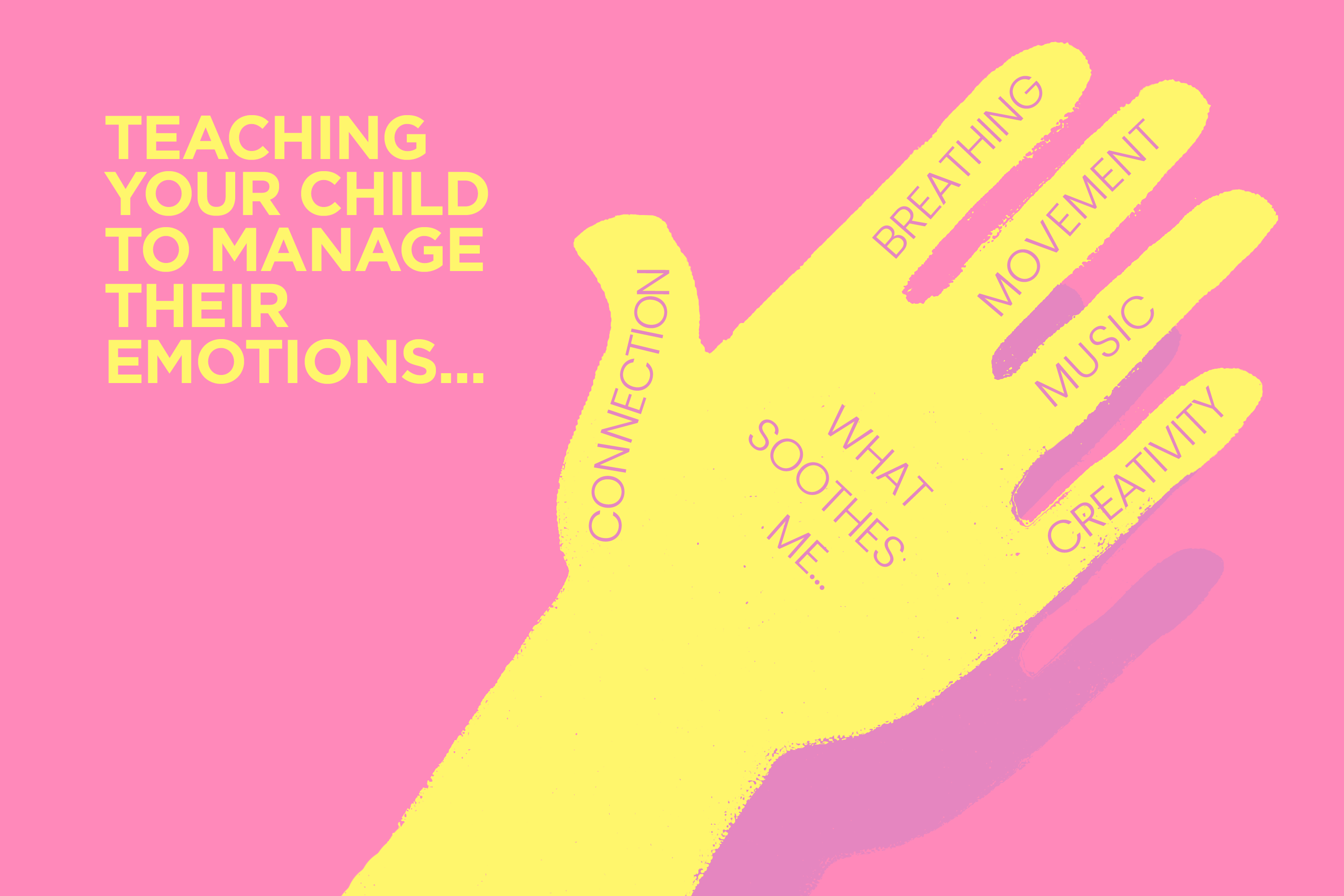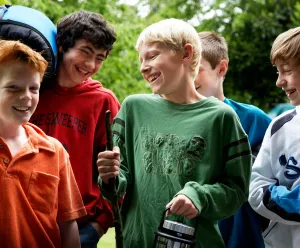Created for Zown by Dr Marcelle Moore, Clinical Psychologist (Child and Family), MA (Hons); MPhil (Sc); DClinPsych; Dip Systemic Practice; Director of Family Jigsaws
Teaching your child to manage their emotion and control their behaviours will help them to manage stress, deal with conflict and reach their goals.
Hand Tracing
Draw around your child’s hand so we can brainstorm 5 ideas that will help your child learn to control and manage their big feelings.
Connection/Togetherness
Co-regulation or connection with another is crucial to helping children manage their emotions. As humans we are biologically predisposed to self-regulate in the context of a relationship.
How do we lend our calmness to children?
- Be present for your child.
- Be in charge of your emotions: stay calm.
- Listen to their story without problem solving.
- Use very little language as children with big feelings do not process language in the way they do when they are calm and in a learning zone.
- Touch and voice tone are powerful tools parents can use to help soothe their child.
- Calm parents are like an emotional blanket for their children. Through connection they help them feel safe, which enables them to begin to feel emotional containment.
- Parents with big feelings simply add to children’s chaos.
- When we feel safe and contained we can begin to regulate our emotions and consequently control our behavior.
- Partnership and togetherness is central to an emotionally healthy child and a positive child-parent relationship.
In summary, children need their parents/caregiver/teacher to lend their calmness to them when they are struggling with their big feelings.
Breathing
Our natural reset to quieten the alarm system in our brain when emotions heighten.
When children or adults are emotionally dysregulated the body and brain is in a hyperaroused state believing there is an imminent and present danger or threat.
The limbic or emotional brain is activated and key organs experience change as a result of the perception of threat. For example, one of the first systems to change is the digestive system when an individual experiences a fight or flight emotional state. This can mean that children who experience big emotions or feelings such as anxiety, can often experience tummy pain or feel like they are going to vomit. This is because digestion has ceased and the tummy has been activated to respond to the perceived threat.
Breathing is considered a neurological reset as it helps with regaining balance in the body and mind systems. Long deep tummy breaths help children and adults to begin to once again regain control and consequently help the nervous system to recover.
There are many different techniques that can be used when we are teaching children how to breathe as a way of managing their emotions. It is the first crucial stage in this process. Breathing can be tailored to the individual child and there are many different fun and creative ways it can be taught.
Breathing Techniques
All of these techniques are usually done by a parent/carer alongside a child which maximises chances of success. When an adult models a technique using actions NOT words, children move towards co-regulated in preference to being alone due to the power of the relationship.
1. Petal Breathing
- Short in-breath in at bottom tip of the finger
- Long out-breath using the pointing finger all the way around each finger until a child goes around all four fingers and thumb.
2. Body Breathing
There are two ways of doing this.
A child lies down and places a soft toy gently on their tummy. They place one hand across their chest. They are asked to take a short breath in for 1-2-3 and then out for 1-2-3-4-5. Children are asked to pay attention to the movement in their chest as it moves up and down and their tummy as the toy moves gently up and down. This technique helps a child’s body return to a more relaxed and calm state.
This technique can also be done standing up by replacing the toy with a hand. This enables a child and adult to be connected to their somatic system which helps emotions and stress to be more effectively managed.
3. Explosive (aka Ninja) Breathing
For more spirited children or when the powerful emotion is anger or rage, explosive breathing is often helpful.
- Children start by standing.
- Take a short breath in, while crouching down to the floor.
- When releasing a long-deep breath out.
- Jump up, planting feet firmly on the floor, while pushing arms out as though they are wings releasing all the tension out of the legs and arms.
4. Square Breathing
- Visualize a square.
- At each corner take a short breath in.
- Use your pointing finger to trace the side of a square while breathing out for the count of 1-2-3.
- Repeat until the square is completed.
5. Noodle Breathing
- Stand upright.
- Take a short breath in, whilst raising your hands above your head.
- Take a deep-long breath out for the count of 1-2-3-4-5 while wiggling down to the floor like a noodle, keep your arms above your head.
6. A grounding technique
Think and say:
- 5 things you can SEE
- 4 things you can FEEL
- 3 things you can HEAR
- 2 things you can SMELL
- 1 thing you can TASTE
This technique is best used when children are NOT fully emotionally dysregulated as it needs them to access existing knowledge. Often most effective after co-regulation and a breathing technique has been used.
Music
Research reports that music has the capacity to change our emotional state in around 7 seconds! Music that we connect to as being upbeat evokes feelings of happiness and causes our brains to produce chemicals like dopamine and serotonin, which triggers feelings of joy.
Listening to music or making music, particularly in a group increases blood flow to the brain and regions that generate and control emotions. The area of the brain is known as the limbic system, which is involved in processing emotions and controlling memory.
Music is consequently an effective tool when trying to help children learn to control their emotions and their behavior as listening to music evokes emotions.
Music has a long history of being used to elicit powerful effects on the mind. Even after hearing a few familiar notes our brain connects. The pain relieving tendencies of music have been well researched and indicate that when our minds are engaged in listening to a melody we connect to, the aching feelings of pain lessen.
When we hear music that moves us, the body releases dopamine, a neurotransmitter associated with well-being often after only hearing a few notes, hence the shift in our emotion.
Playlists
Co-create or ask your child to create a playlist of songs that they emotionally connect to in a calm and happy way. Songs that make them feel relaxed, calm or perhaps joyful. Listening to these songs and connecting to the rhythm, then the lyrics will help children begin to regulate.
Movement
Whilst research has traditionally acknowledged that our emotions impact our engagement with movement, we also know that movement impacts our emotional well-being.
In cultures where dance and music play an integral part of communication dance is a social activity that often involves connection with another. When you are connected with another, co-regulation happens in the safety of the relationship. When you dance with another, your brain relaxes. Your motor neurons in your pre-frontal cortex part of the brain subconsciously map out the actions and minds of another creating a sense of calm and consequently changes your mood state especially in moments of stress and often sadness.
The combination of dance and music releases endorphins as well as neurochemicals that come from the reward part of the brain. This combination of dance and music has been identified as shifting mood states.
Creativity
Any form of art can help reduce stress hormones by increasing endorphins and dopamine in our brains. Creativity promotes feelings of relaxation. Historically the concept of color has been connected to mood state so young children often learn to associate a certain colour with specific mood state.
Drawing
When emotions are heightened, drawing or scribbling can have a calming impact. It represents a distractor from the powerful emotions. Research suggests that kids who draw to distract are often more likely to change their emotional state than those who use drawing to express their unhappy feelings - they seem to get stuck in the moment!
Marker Challenge!
Using art and togetherness can effectively shift mood state. You and your child select 3 markers and each have a set time to simultaneously draw something from your imagination using the 3 markers you selected. Distracting your child with a fun activity you can do together can create safety in the relationship that helps your child to regain emotional balance.
Imaginary Play
The power of distraction! Start playing with small toy figures, cars, lego, whatever your child likes to do, with your child alongside you. They will become curious and as we are hardwired to connect you will soon find yourself a playmate!
For older children, begin reading a book out loud with all the soothing you would have previously done, their curiosity / seeking system will soon be engaged and will replace heightened emotions.









